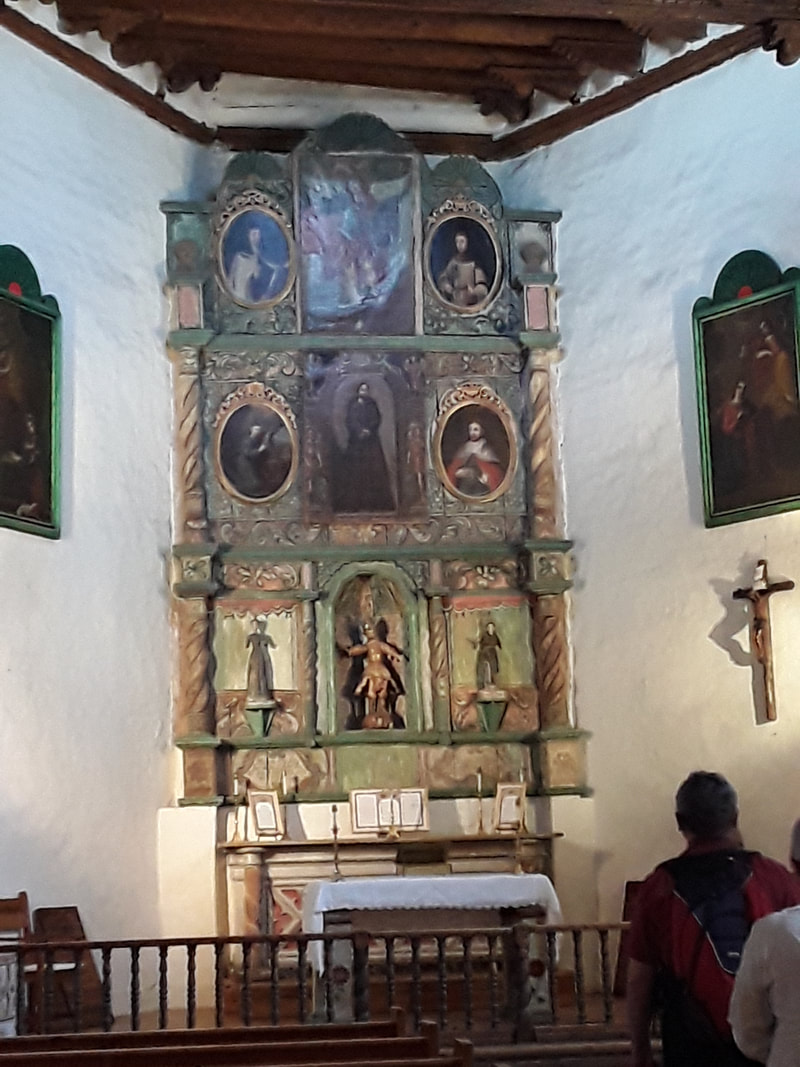The retablo behind the altar in San Miguel Chapel, the oldest church in the United States, is a unique work of art that reflects New Mexico’s multi-cultural heritage.
The word retablo comes from the Latin retro-tabula, literally meaning behind the table, or altar. Originally, the word retablo referred to paintings placed behind the altar of churches in the early Middle Ages. Sometime during the 12th and 13th centuries, the term came to mean any painted sacred image, including those kept in private homes. Santos, one form of retablos, are representations of holy figures, such as members of the Holy Family, or saints.
 San Miguel Retablo by José Rafael Aragón
San Miguel Retablo by José Rafael AragónIn the first years of Spanish occupation, religious art was either imported into New Mexico from Mexico or created in New Mexico by the Franciscan Friars. The art that was imported was influenced by European art, particularly the art of the Renaissance and Baroque periods, while the art created by local monks was often less sophisticated. By the late eighteenth century, local New Mexicans began making their own religious art. Local santeros, or saint makers like José Rafael Aragón (active 1820-1862) developed a simple, primitive style that is distinctively New Mexican.
The retablo in San Miguel Chapel, a carved and painted wooden altar screen studded with paintings and sculptures, was given to the chapel in 1798, by Don Antonio José Ortiz, who had become a devout benefactor of the church after his father was killed by Comanches in 1769. It contains nine works of art, arranged in three rows of three pieces each, and is flanked by columns. The style of the art is varied, demonstrating the different schools of art that have melded into New Mexican tradition over the centuries.
The altar screen itself is believed to have been created by an unnamed artist referred to as the Laguna Santero. Active between 1776 and 1815, scholars think he may have been from southern Mexico, as his work reflects the Baroque style popular there. He is credited with seven other altar screens including the one in Laguna Pueblo’s Chapel de San Jose de Gracia, and the one in Acoma Pueblo’s San Esteban Church.
The altar screen itself is believed to have been created by an unnamed artist referred to as the Laguna Santero. Active between 1776 and 1815, scholars think he may have been from southern Mexico, as his work reflects the Baroque style popular there. He is credited with seven other altar screens including the one in Laguna Pueblo’s Chapel de San Jose de Gracia, and the one in Acoma Pueblo’s San Esteban Church.
 San Antonio
San AntonioThe bottom row contains three bultos, or painted wooden statues. The bulto on the left is of an unidentified saint and is believed to have been carved in New Mexico in the nineteenth century. Scholars know that the center bulto, a Statue of the Archangel Michael, predates 1709, because records indicate it was carried throughout New Mexico to solicit donations for the Chapel’s 1710 reconstruction. It was most likely carved in Mexico and is much more ornate than the other bultos. The bulto on the right is New Mexican, from the early nineteenth century, and depicts San Antonio, or Saint Anthony, the saint whose name graces more place names in New Mexico than any other.
 St. Francis
St. FrancisThe retablo has four oval paintings that are far more European looking than New Mexican. These four paintings might be part of a set of eight that were listed in a 1776 inventory and were presented to the Chapel by the Viceroyalty of New Spain. The one above the bulto of San Antonio depicts San Luis Rey, Saint Louis, or Lois IX, who was King of France from 1226 to 1270 and participated in both the Seventh and Eighth Crusades. Above him is Santa Clara, or Saint Clare of Assisi. A contemporary of Saint Francis, Clare was the co-founder of the Franciscan order of nuns, the Poor Clares. On the other side of the altar screen is an oval depicting San Francisco, or Saint Francis of Assisi, whose name graces the cathedral in Santa Fe. A painting of Santa Teresa, or Saint Teresa of Avila is above the one of St. Francis..

The center of the altar screen has two larger paintings the one on the top is of San Miguel or the Archangel Michael and was painted by Bernardo Miera y Pacheco, a Spanish-born artist, mapmaker, and civic leader, in 1755. Below it is a nineteenth century Mexican painting of Christ the Nazarene. Both of these paintings are a little more primitive in style than the oval paintings.
Although New Mexican religious art may have begun with imports from Europe and Mexico, the isolation of this northern outpost of the Spanish realm soon developed an art that was specific to it. New Mexican art is unique, and both beautiful in its simplicity and generous in its acceptance of outside influences.
Although New Mexican religious art may have begun with imports from Europe and Mexico, the isolation of this northern outpost of the Spanish realm soon developed an art that was specific to it. New Mexican art is unique, and both beautiful in its simplicity and generous in its acceptance of outside influences.

Jennifer Bohnhoff is a native New Mexican who taught New Mexico History at the Middle School level. She is now retired and writing. Her next novel, Where Duty Calls, is historical fiction set in New Mexico during the Civil War, and will be published by Kinkajou, a division of Artemesia Publishing, In June 2022.






No comments:
Post a Comment